Farming on MARS: Challenges and the existing technological options - Colonization of MARS Series
Trying to scour the Internets for any reliable studies regarding IN-SITU resource production and make an easy to read, easy to understand Mars Colonization Handbook. Mars and science in general should not be restricted to established scientists, maybe the next big scientist is you, so I am trying to make you understand it and enjoy it. Science is so fun.
We have talked about the science of producing air, water, energy and about the techonology of getting there in the first place, and now we will address the wannabe Martian farmers.

Source: free to use or share

The science of growing plants
We are going to start by understanding what does a plant essentially need in order to grow and thrive. The process in which plants get their energy is called Photosynthesis, and it's the process of converting light energy into chemical energy. The carbohydrate molecules, like sugars, are synthesized from CO2 and H2O. Oxygen is also released as a byproduct of the reaction. I am not going to enter into details regarding photosynthesis, a fellow Steemian did a wonderful in-depth article that I could never compare to. I am only going to do a quick chemical outline of photosynthesis:
6CO2 + 6H2O -> (in the presence of light) -> C6H12O6 + 6O2
By now we should already know that Mars has a CO2 rich atmosphere and by the time we would need to do farming on Mars we should have already mastered the art of creating oxygen, like it was covered in my previous articles. Water and energy in the form of light would be already supplied by the IN-SITU systems.
The process of research starts with the basic question: Was it attempted or done before?
Of course, we are already pretty advanced with the research here. We have started in 1982, on the Soviet Salyut 7, continued through the Skylab, Mir and ISS, which had what was named "Veggie", the first real vegetable garden in outer space. Many plants were grown, tested and even brought back to Earth with the astronauts eating a part of the harvest on a regular basis for the last 10 years. Here is a short video to get you up to speed with what is considered known about farming in space.
Source: NASA’s Johnson Space Center

Creating the first garden on MARS
According to a study published in the US National Library of Medicine, the first few experiments will analyze using the higher plants for photosynthesis, and hydroponics was the chosen method of growing them. Because the reduced sunlight would affect the photosynthesis process and because of the cold temperature variations, the only method of growing crops before terraforming is to grow them in closed environments.
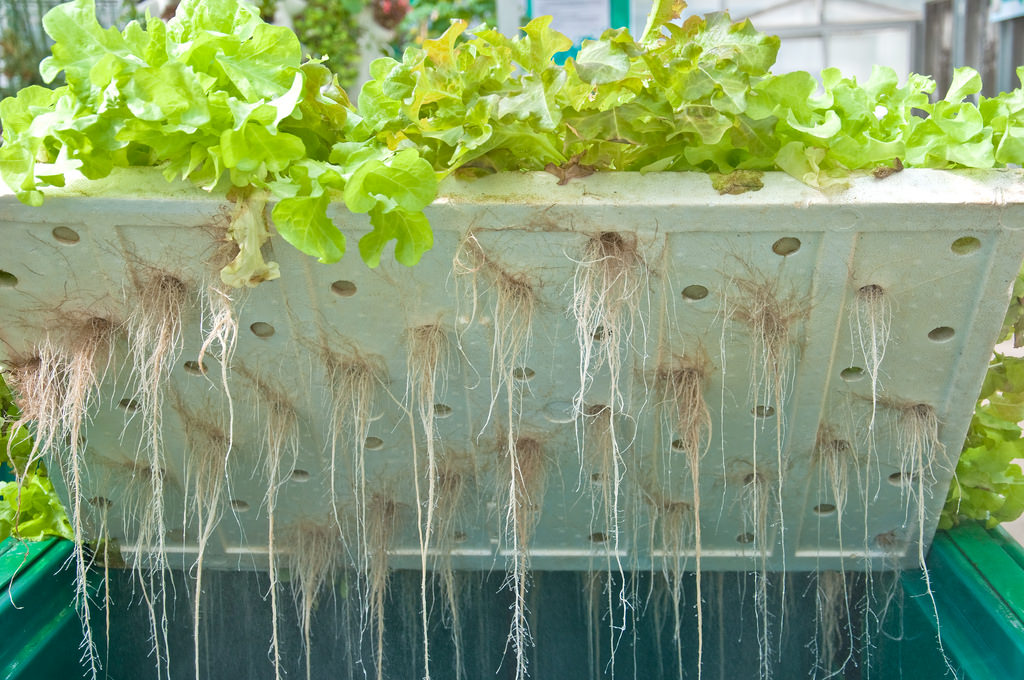 Example of hydroponics. Notice the soil absence.Source
Example of hydroponics. Notice the soil absence.SourceHydroponics is the method of growing plants without soil, only by dissolving nutrients in water. By using perlite or gravel to cover the otherwise exposed roots of the plants (which Mars could supply), only the seeds and the nutriments need to be brought from Earth. NASA is the greatest researcher in this field, managing to use LED lighting in a different color spectrum with increased efficiency. The use of a bigger hydroponics farm could also be used as a bioregenerative life support system. Although there are other variations of the hydroponics such as aeroponics or fogponics, the system's process is largely the same, not needing any subsoil or soil material to grow. Water filtration systems could help us reuse the water or simply use waste water from the colony. More reading about filtration could be found in @temitayo-pelumi's article on activated carbon fundamentals, which is an easy read and a wonderful explanation of the concepts. Even more, such filters could be made IN-SITU, from minerals already present on Mars.

Plants and low gravity - low pressure environments
Plants are able to grow and survive in microgravity but there is more research needed to tell if there are any long term effects of ingestion in terms of the plants chemical structure. Some other studies found out that growing plants in microgravity or zero gravity could increase the risks or flooding or droughts by simply having too much or not enough water just floating around the roots without it being able to flow. In the case of Mars it appears that this is not an issue and the reduced gravity might even play a beneficial role in reducing the water and nutrients needed by the farm, by slowing down the rate of which they flow into the subsoil and away from the roots, thus increasing their exposure time.
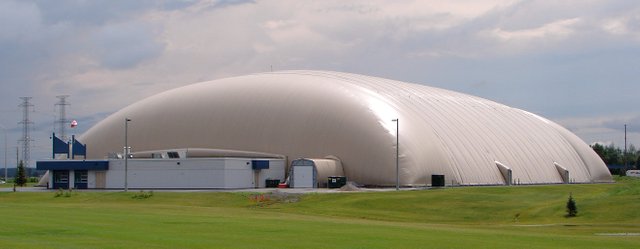
Example of a big dome. On Mars it would be made out of sturdier materials and it would most likely be transparent.Source
Pressurizing a field at the Earth's pressure of one atmosphere needs a lot of engineering and structural support. Thus growing the plants in a pressurized system is much more expensive than just protecting them from the cold, so by using special types of plants that can survive under low pressures, there could be a reduction of a full degree of magnitude on the pressure. Plants can indeed function at a tenth of the Earth's pressure, according to the study. As a further point of research, the GMO industry could come up with even better optimizations for the Martian Atmosphere, including plants that can maintain photosynthesis at very low temperatures or plants that need a reduced intake of minerals from Earth .

What about minerals from Mars? Can we use nutrients produced IN-SITU?
To carry out the photosynthesis process, many nutrients are needed by the plants, the most important of them would be Nitrogen , Potassium and Phosphorus.
Nitrogen (N) is the main component of chlorophyll, responsible for the green color of plants and for facilitating photosynthesis.
Potassium (K) helps to open and close the leaves pores, regulating the water and carbon dioxide (CO2 quantities.
Phosphorus (P) is the main ingredient of photosynthesis.
Thus finding these minerals to be used as fertilizer will be very important in the food self-sufficiency of the colony. It is worth mentioning that human feces could be an important part of obtaining some of these minerals, but through mining, the other minerals could be located and produced locally.
By revisiting our old graphs on the atmospheric composition we can find out that almost 3% is Nitrogen. So we have the following calculation:
Total mass of atmosphere: ~2.5 x 1016 kg
Nitrogen (N2) - 2.7%
Total mass of atmospheric N2: 6.75 x 1014 kg
Surface Area: 1.4437 x 1014 m2
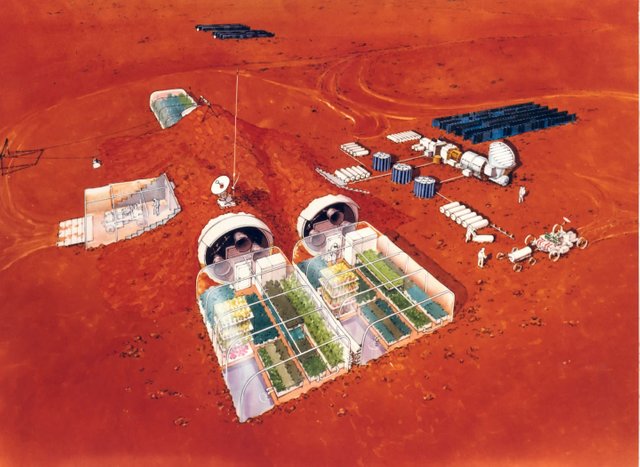 Illustration from NASA's 1980's A Case for Mars study
Illustration from NASA's 1980's A Case for Mars studyThis means that there is sufficient Nitrogen to sustain a thick enough soil to cultivate plants or even plant some trees with deeper roots. We just need to be extracting it from the atmosphere and fix it in the subsoil, at first in small amounts for the greenhouses built and then at a greater scale when terraforming options turn into a reality. I am not able to discuss about this process at length here, called the Haber Process, since it would make my article super long and super boring but I have found @mountainwashere's article about it here and @justtryme90's article both very detailed and correct - also not super long and not super boring, just to be clear :)
There is evidence of other minerals in the composition of igneous rocks as some of the Mars experiments already have uncovered. To find more about igneous rocks, some fellow @SteemSTEM writers with far more understanding of the subject wrote about it (@sooflauschig, here and @the-geekiest-one here). Trace elements of Magnesium, Aluminium, Sulfur, Calcium and Titanium were also found, in lower concentrations than in Earth's crust but in sufficient quantities to at least allow for reduced farming area by shifting soil, even without any GMO modification. In truth, trying to accommodate Earth plants to the Mars environment is probably not the best approach, but regardless, it is possible even now.
Further research on each of the absolutely necessary materials to sustain plant life have given me optimistic results, all have been confirmed in sufficient quantities as to sustain plant development on a widespread scale.

Radiation
It could pose a big problem because of the thin atmosphere that can't protect the crops, and by using thicker and radiation resistant panels would completely obscure the even-so faint sunlight. We could always move the whole farming area underground or in volcanic crevasses or lava ducts but what if we choose to grow them on the surface?
Being born in the same year as the Chernobyl disaster (and close to it) made me very interested in the subject and as time passed I have observed the life around it refusing to wither. Pictures and studies made there show that plants tolerate the radiation pretty well, with only a 5% change in plant proteins, which don't necessarily get transmitted to the next generations. According to a study made by the Slovak Academy of Sciences, which I only read about on Astrobio.net, the plants proteomes seem to remember the early days of Earth formation, when radiation was ever-present and could easily adapt to radiation.
While radiation from Chernobyl is in no way compared to the radiation levels on Mars, the studies remain conclusive about thriving plant life in inhospitable conditions. Further research is needed to determine if the radioactivity changes in those 5% of the proteins would be transmitted to the humans or if GMO crops could identify and disable such changes.

Farming on Mars: It's a GO!
At least in enclosed spaces, using little more than a tenth of the pressure on Earth, which can easily be maintained using composite soft materials which don't take much space. Nutrients can be scavenged IN-SITU, usually as the byproduct of water mining that we discussed in an earlier article, and fertilizer from the colony can be treated and used in this matter, reducing the footprint of the colony even further. LED lighting can be used to increase the reduced solar flux as water and oxygen should already be supplied by the life support systems. GMO seeds could be used to make the plants yield even more by reducing some of the harder-to-get conditions on the surface and having colonists on the ground can make this progress even faster.
It took me a little too long to write this article, but I have tried to cover all aspects of such a vast undertaking. If you feel you can add something, please do so, it's our collective minds that will make Mars possible and I would love to hear from you. Also don't forget to talk about science to your children or friends. Maybe the next scientist is you or right there beside you :P
 Additional sources and further reading: 1, 2, 3
Additional sources and further reading: 1, 2, 3
https://www.space.com/9597-space-farmers-grow-crops-planets.html
https://www.astrobio.net/also-in-news/radiation-no-concern-for-space-crops/
Ask me, as I seem to be able to remember these things, even though I can't remember a five item shopping list :D
Additionally, if you are a new SteemSTEM member, or even if you are not but you want to contribute and better yourself in the process, I am open to give you all the guidance I can.
We are all scientists, it's how our brain works and we can all grow together as a community!



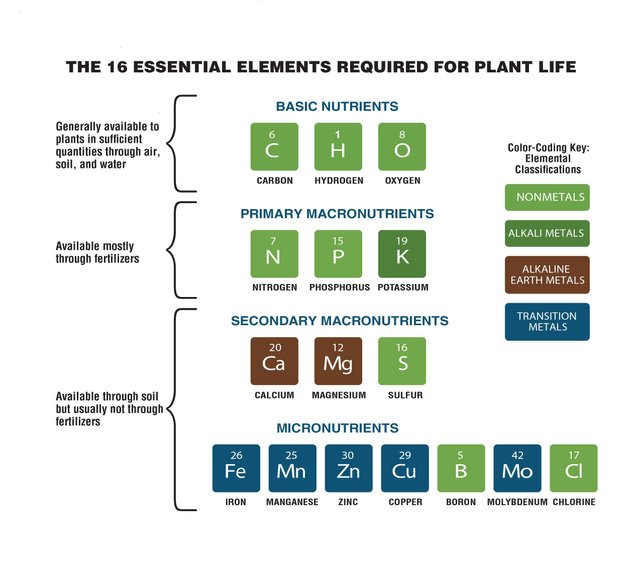
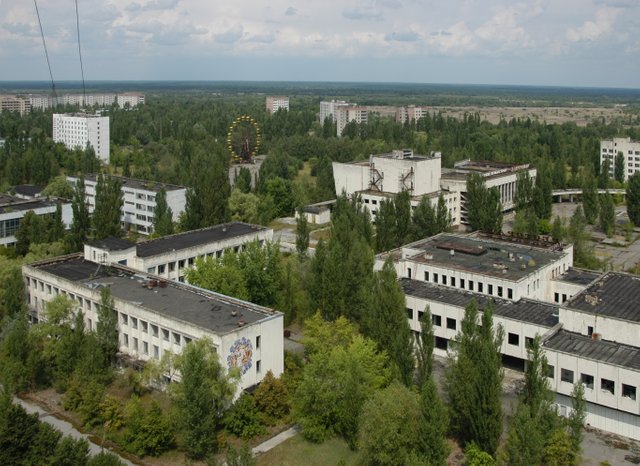
Wow! Thanks for the impressively detailed post. As I was reading through it I started to think about the people that grow cannabis. You would think with their experience growing things in not native conditions under duress, they might be just the type of person that could make a garden grow on Mars. Pair them with a botanist and you might have a winning team! Thanks for sharing your post!
Like @ackza? I found him while documenting my own article! He wrote a great article on the subject. I will have to read his newest articles, because the rewards may have closed to him but his information being shared is timeless. Thanks @ackza :P
Very cool! I will have to check them out.
Congratulations! This post has been upvoted from the communal account, @minnowsupport, by alexdory from the Minnow Support Project. It's a witness project run by aggroed, ausbitbank, teamsteem, theprophet0, someguy123, neoxian, followbtcnews, and netuoso. The goal is to help Steemit grow by supporting Minnows. Please find us at the Peace, Abundance, and Liberty Network (PALnet) Discord Channel. It's a completely public and open space to all members of the Steemit community who voluntarily choose to be there.
If you would like to delegate to the Minnow Support Project you can do so by clicking on the following links: 50SP, 100SP, 250SP, 500SP, 1000SP, 5000SP.
Be sure to leave at least 50SP undelegated on your account.
I applaud your write up @alexdory.
Recent studies have been putting efforts into the colonization of Mars. Getting plants to survive there is a step into achieving this.
Highest regards!
Let's hope that SpaceX doesn't postpone it for long. For now the Martian Phase window of 2022-2024 is targeted but who knows if the BFR will be ready by then.
And that is just an expedition not the actual colony. But it should leave some working systems there, including the Power, Oxygen, Fuel generator.
Very interesting! I hope Elon Musk can get us there. Thanks for sharing! I just shared one on holographic cosmology that you may enjoy.
I read it and it is pretty good. I even left a smart if rather long quote. We have many good authors at @SteemSTEM, so you could broaden your knowledge with ease. There is a lot of quality material to keep you busy for months :D
It's great to see that all of the building blocks are present to be able to sustain plant life on Mars.
It is going to be quite expensive to get the materials there, though. Especially considering the nitrogen requirements.
Now you've got me thinking about whether it would be cheaper to just send fertilizer from Earth to Mars or figure out how to operate the Haber process on Mars. Either option requires sending extensive amounts of materials there. As a chemical engineer, now I'm thinking about the design constraints of such a process in lower pressure and gravity. haha
Thanks for this article. I think you did a great job presenting all of the issues surrounding plant life on Mars in a readable, easy-to-understand way. Keep up the good work. I can't wait to see more articles like this.
I was referring to the Haber process :D but I didn't have time to write about that too. I would make the most boring articles otherwise. I usually search on steemit and provide a link. I will do that before the article locks itself :D if i find a good enough Haber process article on steemit.
Update: I managed to edit that in, actually found two friends that wrote great pieces about it.
Thanks for the input. I don't vote you enough, I know!
I think the Haber process is fascinating. First, because it gave rise to modern farming, and secondly, because hardly anyone has heard of it. It's so important to everyone's lives, but it's one of the marvels of science that largely gets neglected.
Also, the design process is fascinating to me. They had to construct something that could safely operate at huge pressures. No doubt we'll have to do the same thing if we ever stretch out to living on other planets.
Thanks for your thoughts. I haven't really seen any other articles about the Haber process here, but I'm glad that #steemstem is encouraging people to write more posts like this. If I wasn't so busy with my other initiatives, I'd probably write more science-themed posts, too.
I know, I am also trying to cover a lot of ground, but contribute to many things so if they won't be upset that I am only trying to help everyone, I will continue writing about the things I like, it's the only advice that I can give you. At the end of my posting day I am usually happier :D
Hi @Alexdory I found this a very interesting article. It is also interesting that you talk about using lower pressure atmospheres for growing plants, 0.1 Atmosphere, as you say this has enormous implications for reducing structural requirements. Technically, humans can probably cope with 0.5 Atmosphere or lower as well, I am just not too sure if that can be done comfortably.
I have done further reading into the fact that in order to help human maintenance, the soft inflatable materials could withstand temporary pressure increases. This would allow humans to go in without suits for a small amount of time, which would not be that bad for either the humans or the structure. But further research is needed and in the meantime very light spacesuits could be used for that maintenance, which can be complementary assisted by remote controlled robots attached to the ceiling or some VR techniques like the robots performing medical procedures. The science is there and it's so vast that everything can have a solution.
Great research. Thanks for a very informative post.
Thanks! I will try to post more often from now on.
Very interesting! I bumped on the dome image as this may actually be unrealistic for Mars. I remember having read somewhere that the first places to be inhabited on March should be buried underground because of cosmic rays (from which one needs to be protected).
Yes, on my previous article most probably.
The dome is not for inhabitants but for the hydroponic farms. The inhabitants should live underground until technology can protect them better from cosmic radiation since the atmosphere is too thin to actually help (for now). Having to launch huge protective living quarters is not a good approach at this level of tech we have. This might change after terraforming.
Now I am feeling stupid... I should have made the connection... I am probably reading way too much stuff around here :/
Relax ! I am the same when I am tired. Except that my English turns into toddler English too, and my French turns into definitely not French :D
I am always in a relaxed state, don't worry. However, I cam feel stupid at the same time :D
Seems like we are heading to Mars... I find this article very interesting and a new development for scientists. I just hope not only the rich get to enjoy Mars. 😁😁
There are many commercial companies that would like to benefit from the space race nowadays so the cost of actually getting there might be reduced by several orders of magnitude. Private companies always seems to be able to offer a lower price than the state agencies. Something about the public funds being easier to spend :D
This reminded me of the movie I saw sometimes ago; "The Martian". Where Mark Watney planted potatoes in Mars. :D
Oh yes. It was funny. Some things were accurate, others were not. Good movie in the end.
National Geographic had a dramatic series on Mars (half documentary half artistic).
Wow!! Thanks